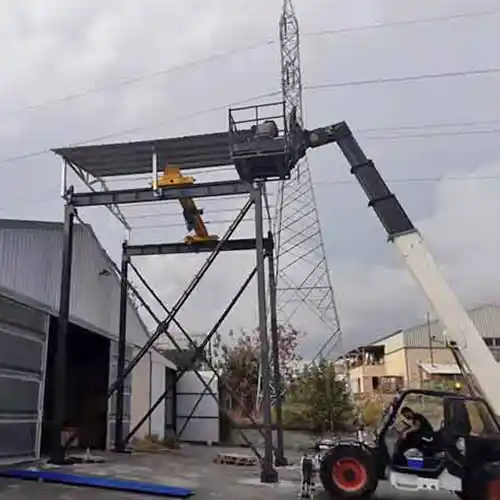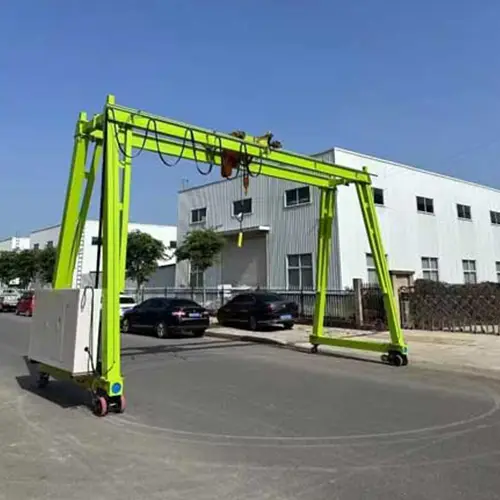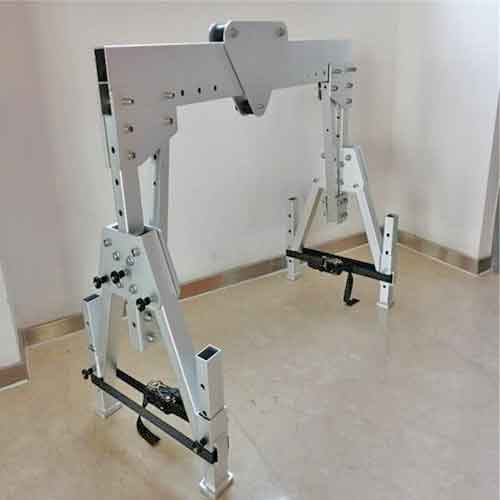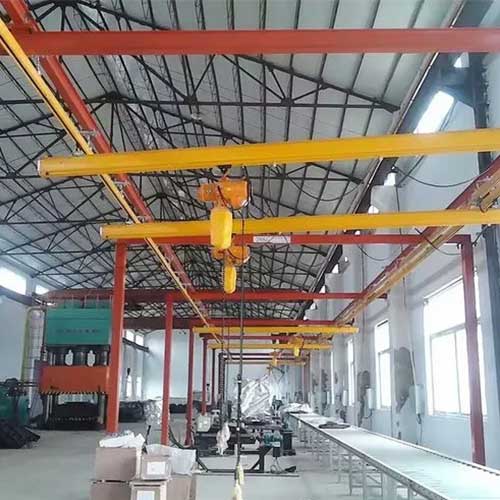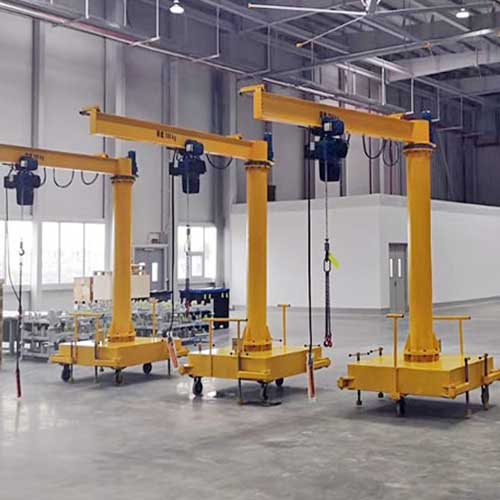Light Duty Overehead Cranes for Sale 500kg, 1 Ton, 2 Ton 3 Ton
500kg, 1 ton, 2 ton, and 3 ton light duty overhead crane, gantry crane, jib cranes for light duty material handling, an essential tool for everyday lifting.
Category: Light Duty Crane 1, 2, 3 Ton
Your Trusted Overhead Crane Manufacturer & Supplier
Light Duty Overehead Cranes for Sale 500kg, 1 Ton, 2 Ton 3 Ton
An Light Duty Tool for Your Material Handling Needs
500kg, 1 ton, 2 ton, and 3 ton light duty overhead crane, gantry crane, jib cranes for light duty material handling, an essential tool for everyday lifting.
Light-duty cranes are essential tools in various industries, designed to handle lighter loads efficiently and safely. These cranes, typically available in capacities of 500kg, 1 ton, and 2 tons, are specifically engineered for applications where heavy lifting is not required. Their lightweight and portable designs make them ideal for small-scale operations, providing a reliable solution for lifting tasks without the bulk of larger cranes.
Importance of Choosing the Right Lifting Solution
Selecting the appropriate lifting equipment is critical for maximizing operational efficiency and ensuring workplace safety. The right crane can:
- Enhance Productivity: Using a crane suited to the task can speed up processes, allowing for quicker handling of materials.
- Prevent Equipment Damage: Overloading a crane can lead to mechanical failures and costly repairs, while underutilizing a heavy-duty crane can result in unnecessary expenses.
- Ensure Safety: Properly matched equipment minimizes the risk of accidents, protecting both workers and materials.
Choosing light-duty cranes helps organizations avoid the drawbacks of oversized equipment, ensuring that operations remain smooth and efficient.
Basics of Light Duty Cranes
Light-duty cranes are specifically designed for lifting and moving lighter loads in a variety of settings. These cranes provide practical solutions for industries that require efficient, reliable lifting without the need for heavy-duty equipment.
Definition and Characteristics
Light-duty cranes are defined by their capacity to handle loads ranging from 500kg to 2 tons. They are typically constructed from durable materials, ensuring strength while maintaining a lightweight design. Key characteristics of light-duty cranes include:
- Weight Capacity: Designed to lift loads that do not exceed specified limits, ensuring safety and performance.
- Construction: Made from high-quality materials such as steel or aluminum, providing a balance of strength and weight.
- Mobility: Often equipped with wheels or a portable base, making them easy to move and reposition as needed.
Crane Design Options for Light-Duty Material Handling
Portable Cranes (250kg, 500kg, 1 ton, 2 ton)
Portable cranes are versatile lifting solutions designed for various applications, allowing for efficient material handling in tight spaces and diverse environments. They are available in different capacities to suit specific lifting needs, including 250kg, 500kg, 1 ton, and 2 ton.
Portable cranes are essential for light-duty material handling, with the capacity to lift loads of 500kg, 1 ton, 2 ton and 3 tons. The manual versions are particularly useful for loads under 2 tons, while electric models cater to heavier applications with enhanced efficiency. Battery-powered portable jib cranes and electric powered portable jib cranes offer versatility and efficiency for various industrial environments.
- 250kg Portable Crane: The 250kg portable crane is ideal for small-scale lifting tasks. Its lightweight and easily maneuverable design make it perfect for workshops and light assembly lines. This crane boasts a compact design that facilitates easy storage and transport. Its manual operation allows for precise control when lifting lighter loads. It is commonly used in home workshops, small repair tasks, and for handling light equipment.
- 500kg Portable Crane: Offering an increased capacity for more substantial lifting needs, the 500kg portable crane maintains portability, making it versatile for various tasks. Available in both manual and electric variants, this crane's compact yet robust design is suitable for small industrial applications. It is commonly utilized in warehouses, maintenance facilities, and for lifting equipment or materials in assembly operations.
- 1 Ton Portable Crane: Designed for more demanding tasks, the 1 ton portable crane provides reliable lifting power without compromising on portability. Electric options are available for efficient lifting and handling, while adjustable height features enhance flexibility for various applications. This crane is ideal for light industrial use, such as lifting pallets, machinery, and materials in workshops and factories.
- 2 Ton Portable Crane: The 2 ton portable crane is a high-capacity option suitable for heavier loads, offering a balance of strength and portability. Equipped with advanced lifting mechanisms, this crane enhances safety and efficiency. Its robust construction ensures durability and reliability in demanding environments. Commonly found in construction sites, large warehouses, and manufacturing plants, it is used for lifting heavy machinery and materials.
Portable cranes in various capacities—250kg, 500kg, 1 ton, and 2 ton, —offer flexibility and efficiency for diverse lifting tasks. Their design allows for easy movement and operation, making them essential tools in workshops, warehouses, and industrial environments. Each capacity is tailored to meet specific needs, ensuring safe and effective material handling.
Portable cranes are versatile solutions designed for light-duty material handling, offering efficient lifting options across various environments. They can effectively handle loads of 500kg, 1 ton, and 2 tons, making them suitable for a wide range of applications.
Portable Gantry Crane:
- Manual Gantry Crane: Ideal for handling loads under 2 tons, this hand-operated crane is designed for low-cost applications and is particularly useful for lifting equipment in small workshops. Lightweight, easy to transport, and set up, it allows for flexible use in confined spaces.
- Battery-Powered Gantry Crane: Ideal for remote or outdoor applications, this crane is capable of handling loads up to 2 tons while offering enhanced mobility. Operates without needing power outlets, making it versatile for construction sites and other outdoor environments.
- Electric Gantry Crane: Suitable for handling loads of 500kg, 1 ton, and 2 tons, this crane utilizes an electric hoist for automated lifting. It can also handle heavier loads, with capacities reaching up to 10 tons. Reduces manual labor and increases efficiency, making it ideal for frequent use in various industrial settings.
Customized Options for Light-Duty Gantry Cranes
Light-duty gantry cranes can be customized to enhance their versatility and efficiency in various applications. Here are the key options available:
Material Selection
- Steel Gantry Cranes:Strength and Durability: Ideal for robust applications and heavier lifting tasks.
- Aluminum Gantry Cranes:Lightweight and Portable: Perfect for environments requiring mobility and handling lighter loads.
Height and Span Adjustability
- Height Adjustable:Flexible Operation: Users can modify the crane height to suit different lifting requirements.
- Span Adjustable:Accommodates Various Loads: Allows adjustment of the width between crane legs to fit different workspace configurations.
Hoist Options
- Manual Hoist:Cost-Effective and Simple: Suitable for lighter loads and applications without electricity.
- Electric Hoist:Enhanced Efficiency and Speed: Ideal for frequent lifting tasks or handling heavier loads.
Customized light-duty gantry cranes, featuring options for material selection, height and span adjustability, and hoist types, provide businesses with the flexibility needed to meet diverse lifting requirements effectively. These tailored solutions significantly enhance productivity and safety across various operational environments.
Light-duty jib cranes are versatile lifting solutions designed for handling loads of 1 ton, 2 tons, or 3 tons with ease. These cranes feature a compact and flexible design, making them ideal for small workshops and assembly lines where space is limited. With 360° rotation and smooth maneuverability, they are perfect for precise load positioning. Built with durable yet lightweight materials, these cranes offer reliable performance with minimal maintenance. They are a cost-effective solution for enhancing productivity in various industrial applications, including material handling, maintenance, and repetitive lifting tasks.
Portable Jib Crane:
- Manual Jib Crane on Wheels: Designed for light loads up to 2 tons, this easily movable, hand-operated crane is perfect for small workshops and assembly tasks. Compact and portable, it provides flexibility and efficiency in material handling.
- Battery-Powered Portable Jib Crane: This crane is portable and efficient for locations without power access, effectively handling loads up to 2 tons. Combines mobility with power independence, suitable for outdoor jobs and remote sites.
- Electric Powered Portable Jib Crane: Capable of handling loads up to 2 tons, this electric version enhances efficiency for lifting tasks in maintenance and repair areas. Offers automated lifting, significantly reducing the physical effort required for lifting operations.
Portable Jib Crane Specifications
Capacity: Portable jib cranes are typically available in capacities ranging from 250kg to 2 tons. The lifting capacity determines their suitability for various applications, from light tasks to more demanding lifting operations.
Cantilever Length: Cantilever length varies based on the crane's lifting capacity. Generally, when the lifting capacity is lower, the cantilever length can be longer. This flexibility allows for greater reach while maintaining stability and safety during operations. Standard cantilever lengths can range from 2 meters to 6 meters, depending on the model.
Lifting Height: Lifting height can be customized to meet specific application requirements. Portable jib cranes often have adjustable height options, allowing users to set the crane to the desired lifting height, which typically ranges from 2 meters to 4 meters. Note that underground lift heights are not included in this specification.
Rotating Options:
Portable jib cranes can come with different rotating options:
- Fixed Cantilever: This configuration provides stability and is ideal for applications where the lifting point remains consistent.
- 360-Degree Rotation: This option allows the crane to rotate fully around the base, providing increased versatility and reach. It is particularly beneficial for tasks that require multiple angles of access to the load.
These specifications ensure that portable jib cranes can effectively handle a variety of lifting tasks in diverse environments, offering flexibility and efficiency for material handling.
Light Duty Overhead Cranes for 1Ton, 2 Ton, 3 Ton Material Handling
Light-duty overhead cranes are essential tools in various industrial settings, designed to handle loads ranging from 500kg to 2 tons. These cranes offer a perfect blend of functionality and efficiency, allowing for smooth material handling and improved workflow in warehouses, workshops, and assembly lines. Their design features typically include a lightweight structure, compact dimensions, and high maneuverability, making them suitable for tight spaces and varied applications.
Light-duty overhead cranes are characterized by their user-friendly designs, which often incorporate electric hoists for efficient lifting. Key benefits include enhanced safety features, such as overload protection and easy-to-use controls, which ensure safe operation. The flexibility of these cranes allows for various configurations, such as top running and underslung designs, to suit different facility layouts and lifting needs.
Light duty overhead cranes are designed to efficiently handle lighter loads while maximizing space and flexibility in various industrial environments. Below are the key types and their specific features:

Telescopic Overhead Cranes 500kg, 1 Ton, 2 Ton
Telescopic overhead cranes are designed with adjustable arms that provide versatile load handling capabilities. These cranes can extend and retract, allowing for precise control over lifting height, making them ideal for environments where frequent height adjustments are necessary. The standard design can be used for loads handling up to 3 ton, and hot sale capacity is 500kg, 1 ton, 2 ton. Key features include:
- Adjustable Arms: Allow for flexibility in lifting height to suit various operational needs.
- Compact Design: Facilitates movement in tight spaces, enhancing maneuverability.
- Compact Storage: Can be retracted for easy storage when not in use.
- Enhanced Stability: Provides reliable support for varying loads.
Typical Applications: Telescopic overhead cranes are often used in assembly lines, manufacturing facilities, and maintenance workshops, where different lifting heights are required for handling various materials and equipment.

Underhung Bridge Cranes 500kg, 1 ton, 2 ton, 3 ton
Underhung bridge cranes are directly installed from the ceiling, providing exceptional flexibility in space utilization. Their design is particularly advantageous for areas with limited floor space, such as narrow aisles or tight corners in warehouses.Mounted directly from the ceiling, these cranes offer high flexibility in space usage. Capable of handling loads of 500kg, 1ton, 2 ton, 3 ton, they are perfect for areas with limited floor space, such as narrow aisles or tight corners in warehouses. The standard design can be used for loads handling up to 10 ton, and hot sale capacity is 2 ton, 3 ton, 5 ton. Key features include:
- Direct Ceiling Mounting: Maximizes usable floor space and allows for efficient movement of materials.
- Space-Saving Design: Ideal for facilities with height restrictions.
- Lightweight Construction: Easier to install and maintain compared to heavier cranes.
- Versatile Load Capacity: Can handle loads ranging from 500kg to 3 tons, with standard designs accommodating up to 10 tons.
Typical Applications: These cranes are commonly found in manufacturing plants, warehouses, and distribution centers, where optimizing vertical space is essential for effective material handling and storage.

Top Running Single Girder Electric Chain Overhead Crane 1ton 2 ton, 3 ton
The top running single girder electric chain overhead crane features a streamlined design that utilizes a single girder structure equipped with an electric chain hoist. This configuration is particularly suitable for a range of lifting tasks, providing efficient and reliable performance. It can handle loads with capacity of 1, 2, 3 tons, making it suitable for a range of lifting tasks, including assembly line operations and material handling in warehouses. Its compact design allows for efficient use of vertical space.The standard design can be used for loads handling up to 20 ton, and hot sale capacity is 3 ton, 5 ton, 10 ton. Key features include:
- Electric Chain Hoist: Ensures efficient lifting and lowering of loads with minimal effort.
- Compact Structure: Maximizes vertical space, ideal for facilities with high ceilings.
Typical Applications: These cranes are widely used in assembly line operations, warehouses, and manufacturing facilities for lifting pallets, machinery, and heavy materials. They can handle loads ranging from 1 ton to 3 tons, with standard designs supporting up to 20 tons. Common capacities include 3 tons, 5 tons, and 10 tons.
The variety of overhead cranes, including telescopic models, ceiling mounted underhung options, and top running single girder designs, offer tailored solutions for diverse material handling needs. Each type provides unique features that enhance efficiency, safety, and adaptability in various industrial settings, ensuring effective lifting operations across a wide range of applications.
Design Features of Light Duty Overhead Crane 1 Ton, 2 Ton, 3 Ton
Overhead cranes designed for indoor use are characterized by their robust construction and efficient lifting capabilities, making them ideal for handling loads of 1 ton and 2 tons. Key design features include:
Top Running or Underhung Configuration:
- Top Running Cranes: These cranes run on rails installed on the top of the supporting structure, allowing for maximum lifting height and load capacity.
- Underhung Cranes: Suspended from the building structure, these cranes save floor space and are suitable for facilities with height restrictions, offering flexibility in design and operation.
Electric Hoist Systems: These cranes are typically equipped with electric chain or wire rope hoists that ensure efficient and reliable lifting operations, allowing for precise control and increased lifting speed.
Safety Features: Overhead cranes incorporate mechanisms such as overload protection, limit switches, and emergency stop buttons to enhance operational safety and prevent accidents during lifting tasks.
Optimal Choice for Facility Layout:
Overhead cranes are particularly optimal in environments where:
- Vertical Space is Available: The overhead design allows for maximum use of vertical space, making it ideal for facilities with high ceilings, thereby facilitating the lifting of larger loads.
- Frequent Lifting Needs: Their efficiency in lifting and moving materials makes them suitable for operations that require regular handling of loads, increasing productivity in the workplace.
- Complex Layouts: They can navigate around columns and other obstructions, providing flexibility in tight or intricate facility layouts, which is essential in many industrial settings.
Overhead cranes with capacities of 1 ton, 2 tons, and 3 tons are widely utilized across various industries for efficient material handling. Here's an overview of the typical loads these cranes manage:
1 Ton Loads
Overhead cranes with a 1-ton capacity are ideal for handling lighter machinery and components. They are frequently used in:
- Assembly Lines: Lifting smaller parts and tools for efficient assembly processes.
- Workshops: Moving equipment and materials with ease in repair and maintenance tasks.
- Light Industrial Applications: Handling light construction materials, such as drywall or small pallets.
2 Ton Loads
Cranes with a 2-ton capacity are designed for more substantial lifting tasks, making them suitable for:
- Large Equipment: Safely lifting and relocating heavier machines, such as generators and compressors.
- Pallets: Handling bulk materials and product pallets in manufacturing and distribution centers.
- Construction Materials: Moving heavy items like steel beams, concrete blocks, and large tools on construction sites.
3 Ton Loads
Overhead cranes capable of lifting 3 tons are versatile tools that cater to a variety of heavier lifting needs, including:
- Industrial Machinery: Transporting larger machines that require robust support during installation or maintenance.
- Heavy Components: Handling substantial automotive parts or large electrical equipment in factories.
- Construction Applications: Moving larger building materials, such as metal frameworks or pre-assembled structures, efficiently across job sites.
The adaptability of overhead cranes allows them to manage a diverse range of loads effectively. Their application across different capacities ensures that both light and heavy lifting tasks are completed with precision and safety in various industrial settings.
Optional Features for 1 T, 2 Ton, 3 Ton Overhead Bridge Cranes
Freestanding Bridge Crane with Supporting Columns
Description: Freestanding bridge cranes are supported by their own columns, allowing for independent installation without relying on existing building structures.
Key Features:
- Flexible Layout: Customizable configurations to fit various facility sizes and operational needs.
- High Load Capacity: Designed to handle loads efficiently, often exceeding standard capacities.
- Enhanced Stability: Robust construction ensures stability during operation, making them ideal for heavy lifting tasks.
Applications: Suitable for large-scale industrial operations where flexibility in layout is essential.

Outdoor Overhead Cranes for 2 ton Outdoor Material Handling
Description: These cranes are specifically designed to withstand harsh weather conditions, making them ideal for outdoor material handling applications.
Key Features:
- Weather-Resistant Construction: Built from durable materials and coatings that resist corrosion, rain, wind, and UV exposure.
- Adaptable Lift Mechanisms: Equipped with reliable electric or hydraulic hoist systems for efficient lifting capabilities.
- Safety Features: Includes weatherproof control systems and emergency stop functions for enhanced operational safety.
Applications: Ideal for construction sites, loading docks, and outdoor storage areas.

Customized Based on Your Requirements
Description: Overhead cranes can be tailored to meet specific operational needs and facility requirements.
Key Features:
- Personalized Specifications: Options for customized span lengths, lifting heights, and load capacities.
- Specialized Attachments: Ability to integrate various hoist types and lifting mechanisms based on the application.
- Enhanced Control Systems: Options for advanced control features, including remote operation and automated functions.
Applications: Perfect for unique operational settings where standard configurations may not suffice.
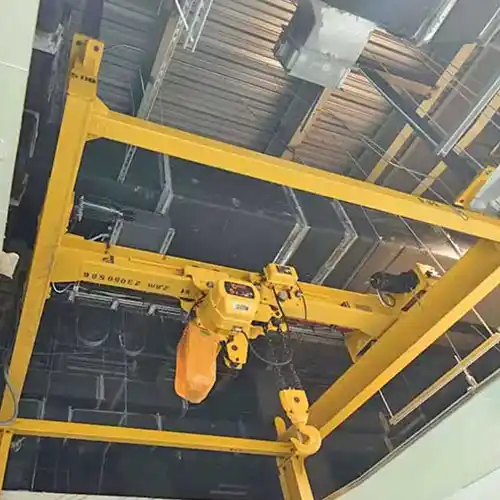
These optional features for 1 ton and 2 ton overhead bridge cranes enhance versatility and functionality, catering to a wide range of industrial applications. Whether you need a freestanding crane for flexibility, an outdoor crane for tough environments, or a customized solution tailored to your specific requirements, these options provide robust support for effective material handling.
Light-Duty Jib Cranes for 1 Ton, 2 Ton, and 3 Ton Light Duty Material Handling
Light-duty jib cranes are essential tools in industrial settings, providing efficient solutions for material handling tasks. These cranes are designed to enhance productivity while maximizing space utilization. Their key design features, such as adjustable arms and robust construction, allow for precise control in lifting operations. Typical benefits of light-duty jib cranes include improved access to hard-to-reach areas, increased lifting efficiency, and the ability to perform tasks in tight spaces. With their versatility, they find applications in workshops, assembly lines, warehouses, and maintenance areas.
Wall Mounted Jib Crane 2 Ton: Attached to walls, saving valuable floor space, ideal for short-distance handling and frequent lifting tasks. can be used for handling loads up to 3 ton, and standard load capacity is 5 ton, hot sale capacity, is 500kg, 1 ton, 2 ton, 3 ton,
Key Features:
- Space-saving design, ideal for crowded workspaces.
- Simple installation and maintenance.
Benefits:
- Maximizes available floor space.
- Provides quick access for lifting operations.
Applications: Commonly used in workshops, assembly lines, and maintenance facilities for lifting tools, components, and lightweight equipment.

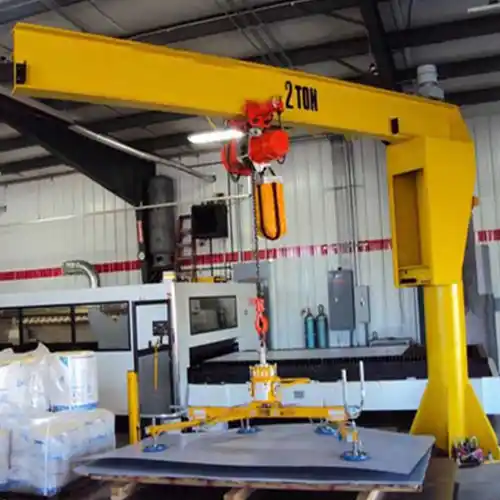
Floor Mounted Jib Cranes: 2 Ton Freestanding and stable, perfect for various lifting applications, allowing for 360-degree rotation and enhancing accessibility, can be used for handling up to 3 ton, standdard capacity is for handling loads 16 ton, hot sale capaity is 1 ton, 2 ton, 3 ton, tons.
Key Features:
- Freestanding design allows for versatile placement in any facility.
- Rotational capabilities improve lifting efficiency.
Benefits:
- Offers enhanced reach and flexibility for material handling tasks.
- Durable construction ensures reliability in demanding environments.
Applications: Ideal for manufacturing plants, warehouses, and construction sites where lifting heavy machinery, tools, or materials is required.
Light-duty jib cranes provide effective and versatile solutions for various material handling needs. Their design options cater to different lifting capacities, ensuring that businesses can select the right crane for their specific applications, ultimately enhancing productivity and safety in the workplace.
Optional Design Features for 1 Ton, 2 Ton, and 3 Ton Jib Cranes
Jib Crane Mounted Types:
- Floor Mounted Pillar Jib Crane: Provides stability and allows for 360-degree rotation, making it ideal for heavy-duty applications in spacious environments.
- Wall Mounted Jib Crane: Saves floor space by attaching directly to walls, perfect for short-distance handling in tight work areas.
Rotating Design:
- Electric Rotation: Offers smooth and effortless movement, ideal for applications requiring frequent rotation with full 360-degree capability.
- Manual Rotation: Allows for controlled movement with lower power consumption, suitable for tasks with infrequent rotation needs.
- Rotation Degrees: Available in fixed angles (e.g., 180 degrees) or full 360-degree rotation options, depending on specific operational requirements.
Jib Hoist Options:
- Manual Chain Hoist: Cost-effective for lighter loads, allowing for precise control during lifting operations.
- Electric Chain Hoist: Enhances lifting efficiency for heavier loads, featuring variable speed control and overload protection for safe operation.
These design features enhance the versatility and functionality of 1 ton, 2 ton, and 3 ton jib cranes, ensuring they meet a wide range of industrial applications.
Typical Loads Handled by Light Duty Jib Cranes
- 1 Ton Loads:Commonly used for lifting smaller machinery, components, and materials in workshops and assembly lines. Ideal for light industrial applications, such as handling parts in automotive assembly or lifting tools in maintenance tasks.
- 2 Ton Loads:Suitable for heavier lifting tasks, including large equipment, pallets, and construction materials. Frequently found in manufacturing environments, warehouses, and distribution centers, where they assist in moving goods efficiently.
- 3 Ton Loads:Designed for lifting even heavier items, such as heavy machinery, large fabrications, or bulk materials. These jib cranes are ideal for use in construction sites, fabrication shops, and industrial facilities where robust lifting capabilities are essential.
Overall, jib cranes provide effective solutions for a variety of lifting tasks across multiple industries, enhancing operational efficiency and safety.
Specialized Light-Duty Cranes for 1 Ton, 2 Ton, and 3 Ton Load Handling
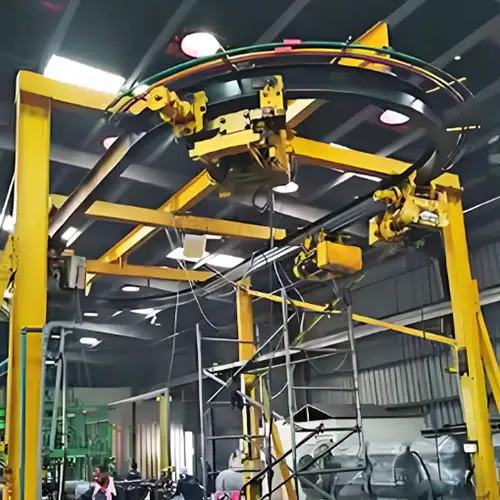
Monorail Cranes:
Monorail cranes utilize straight or curved rails, providing an efficient solution for transporting loads along a designated path. They are particularly useful in environments where space is limited and movement needs to be streamlined.
Typical Applications: Ideal for assembly lines, manufacturing plants, and warehouses, facilitating the movement of materials and components.
Typical Loads Handling:
- 1 Ton: Small machinery, tools, and components.
- 2 Tons: Pallets of materials, large equipment, and subassemblies.
- 3 Tons: Bulk materials, heavy fixtures, and industrial supplies.

Rigid Truss Girder KBK Cranes:
These cranes offer a robust design for stable operations, making them suitable for heavy-duty tasks within confined spaces.
Typical Applications: Used in assembly stations, maintenance areas, and production lines for precise load handling.
Typical Loads Handling:
- 1 Ton: Workpieces, light machinery, and equipment.
- 2 Tons: Larger machine parts, heavy tools, and crates.
- 3 Tons: Complete assemblies, heavy fixtures, and equipment stacks.

Flexible KBK Rail Cranes:
These cranes provide a flexible and modular solution for varying workspace requirements, allowing for easy adjustments and reconfigurations.
These cranes provide a flexible and modular solution for varying workspace requirements, allowing for easy adjustments and reconfigurations.
Typical Applications: Commonly found in workshops and light manufacturing settings, where adaptability in load handling is crucial.
Typical Loads Handling:
- 1 Ton: Small parts, tools, and light equipment.
- 2 Tons: Medium-sized machinery, pallets, and large components.
- 3 Tons: Heavy machinery, industrial materials, and large assemblies.
Applications of Light Duty Cranes
Light-duty cranes are versatile tools that find applications across various industries. Their ability to handle lighter loads efficiently makes them invaluable in settings that require frequent lifting and moving tasks.Small-scale Manufacturing
In small-scale manufacturing environments, light-duty cranes play a crucial role in optimizing production processes. Common use cases include:- Workshops: Light-duty cranes are used to lift and position materials, tools, and machinery. They help streamline workflows by allowing workers to easily move components to different areas of the workshop.
- Assembly Lines: These cranes assist in lifting parts into place during assembly, reducing strain on workers and increasing speed. They enable precise handling of delicate components, minimizing the risk of damage.
Warehousing and Distribution
In warehousing and distribution settings, light-duty cranes are essential for efficient material handling. Their applications include:- Lifting and Moving Lightweight Products: Light-duty cranes facilitate the movement of boxes, pallets, and equipment, making it easier to organize inventory and optimize storage space.
- Order Fulfillment: These cranes assist in picking and packing orders by lifting items to the appropriate height for packing or shipping, improving order accuracy and reducing labor costs.
Construction and Renovation
Light-duty cranes are invaluable on construction sites, particularly for tasks that do not require heavy lifting. Their applications include:- Lifting Tools and Materials: Light-duty cranes can lift construction tools, lightweight building materials, and equipment, helping to keep work areas organized and efficient.
- Renovation Projects: During renovations, these cranes assist in handling fixtures, cabinetry, and other components, allowing for precise positioning and installation without the need for more substantial lifting equipment.
Maintenance and Repair
In maintenance and repair operations, light-duty cranes provide essential support for various tasks. Their applications include:- Supporting Machinery and Equipment: These cranes help lift and position machinery for repairs, making it easier to access components that require servicing.
- General Maintenance Tasks: Light-duty cranes can be used to lift equipment for routine inspections or maintenance, ensuring that workers can perform their tasks safely and efficiently.
Advantages of Light Duty Cranes
Light-duty cranes offer numerous advantages that make them an attractive choice for businesses seeking efficient and practical lifting solutions. Here are some key benefits:Cost-Effectiveness
One of the most significant advantages of light-duty cranes is their cost-effectiveness. This includes:- Lower Purchase Costs: Compared to heavy-duty cranes, light-duty options are more affordable, allowing businesses to invest in reliable lifting equipment without straining their budgets.
- Reduced Maintenance Costs: Light-duty cranes typically have fewer moving parts and simpler mechanisms, resulting in lower maintenance requirements. This means businesses can save on repair costs and downtime.
Versatility
Light-duty cranes are adaptable to a wide range of tasks across different industries, making them highly versatile. Key points include:- Multi-Functional Use: They can handle various materials and products, from small components in manufacturing to light fixtures in construction, making them suitable for multiple applications.
- Customization Options: Many models offer attachments or configurations that can be tailored to specific lifting needs, enhancing their utility in diverse environments.
Space Efficiency
In environments where space is limited, light-duty cranes excel due to their compact design. Benefits include:- Compact Size: Light-duty cranes occupy less floor space, making them ideal for small workshops, crowded warehouses, and busy construction sites.
- Mobility: Many models are designed with wheels or portable bases, allowing for easy repositioning without requiring extensive space for setup.
User-Friendly Design
Light-duty cranes are designed with the user in mind, ensuring ease of operation and minimal training requirements. This includes:- Simple Operation: Most light-duty cranes feature intuitive controls that allow operators to lift and lower loads with ease, enhancing workflow efficiency.
- Minimal Training Needed: The straightforward design means that new operators can quickly learn to use the equipment, reducing onboarding time and increasing productivity.
Selecting the Right Light Duty Crane
Choosing the right light-duty crane involves careful consideration of several key factors to ensure it meets your specific lifting needs. Here's a breakdown of the essential elements to consider:Capacity Considerations
Determining the appropriate load capacity is crucial for safe and efficient operation. Key points include:Load Requirements: Assess the maximum weight you expect to lift regularly. Light-duty cranes typically come in three main capacities:- 500kg: Suitable for small components and tools in workshops.
- 1 Ton: Ideal for general warehousing and light manufacturing tasks.
- 2 Ton, 3Ton: Best for slightly heavier items, such as construction materials and equipment.
Environment and Space
Evaluating the environment where the crane will be used is essential for optimal performance. Considerations include:- Workplace Conditions: Assess factors such as the presence of dust, moisture, or chemicals that might affect crane performance. Some cranes may offer additional features, such as corrosion-resistant coatings for challenging environments.
- Layout: Analyze the space available for the crane, including ceiling height, floor space, and potential obstacles. Ensure that the crane can maneuver freely without interference, and consider the need for portable options if your tasks vary frequently.
Additional Features
When selecting a light-duty crane, consider additional features that may enhance functionality and usability:- Customization Options: Many cranes can be tailored with specific attachments or modifications to suit particular tasks, such as hooks, clamps, or lifting beams.
- Mobility Look for cranes with wheels or collapsible designs that allow for easy transport and storage, especially if space is at a premium.
- Safety Enhancements: Features like load indicators, locking mechanisms, and emergency shut-off controls can improve safety during operation, making them important considerations in your selection process.
Safety and Maintenance
Ensuring safety and proper maintenance of light-duty cranes is vital for effective operation and longevity. Here's an overview of best practices and guidelines:Safety Tips for Operating Light Duty Cranes
To promote safe lifting practices, consider the following best practices:- Conduct Pre-Operation Inspections: Before each use, check the crane for any visible damage or wear. Inspect critical components like hooks, chains, and wheels.
- Follow Load Limits: Never exceed the crane's rated capacity. Always verify the weight of the load to ensure it falls within the safe lifting range.
- Use Proper Techniques: Ensure loads are balanced and secure before lifting. Avoid sudden movements and use slow, controlled motions to minimize risks.
- Maintain Clear Communication: Use hand signals or radios to communicate with team members during operations. Ensure everyone is aware of the lifting process and their roles.
- Keep the Work Area Clear: Ensure that the area around the crane is free of obstacles and bystanders. Establish a safe zone to prevent accidents during lifting operations.
Maintenance Guidelines
Regular maintenance is essential for ensuring the crane operates safely and effectively. Consider the following guidelines:- Routine Checks: Perform daily inspections to assess the condition of the crane. Check for wear and tear on cables, wheels, and lifting mechanisms.
- Maintenance Schedules: Establish a regular maintenance schedule based on usage. For example, conduct thorough inspections weekly or monthly, depending on the crane's workload.
- Lubrication: Regularly lubricate moving parts to reduce friction and wear. Follow manufacturer recommendations for specific lubricants and application methods.
- Professional Servicing: Consider periodic professional maintenance checks to ensure compliance with safety standards and identify any potential issues before they become serious problems.
Main Projects
Related Products

Supplied three grab bucket crane kits to Indonesia, enhancing garbage handling efficiency with high load capacity and reliable performance.
Free consultation to Confirm Parameters & Specifications and Get
Latest Crane Price & Crane Rate.
- Types of overhead cranes : _______?
- Optional: Overhead travelling crane, goliath gantry crane,Slewing jib crane, Single girder or double girder crane,small portable crane or kbk crane, etc.
- Capacity of overhead crane: _______?
- Optional: 0.25ton, 0.5 ton, 1 ton, 2 ton, 3ton, 5 ton, 10 ton,15ton, 20ton, 25 ton, 30ton,35ton, up to 550ton, etc.
- Crane span & lifting height : _______?
- Crane travelling length : _____?
- Control of overhead crane:_______?
- Optional: pendant/ remote/cabin control
- Voltage supply of overhead crane:_____?
- Eg,: 380V50/60HZ,3Phase or others,etc.
- Application/usage of crane:_______?
- Eg,: Steel mill, ,injection mold, cement,stone, concrete,granite, general manufacturing, etc.
Just leave a message via the contact form and our hoist and crane engineer will contact you with in 24working hours.
Get In Touch
